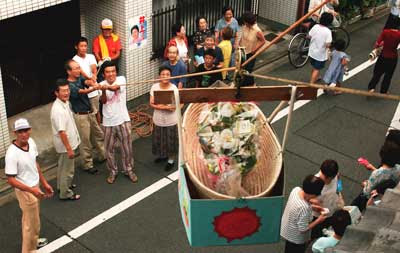:::::::::::::::::::::::::::::::::::::::::::::::::::::::::::::::::::::::::::::::::::::::::::::::::::
First Day of the Tiger (hatsu tora)
***** Location: Japan
***** Season: New Year
***** Category: Observance
*****************************
Explanation
The old Japanese calendar, instead of using the seven days of the week, used twelve different zodiac animals to symbolize each day. So, in a sense, today's 'seven day' week, was once a 'twelve day' period.
The Tiger hour is about 3-5am. Tiger Month is January and Tiger day comes up every 12 days.
The temple Kurama in Kyoto is especially closely related to this day. In Tokyo you can visit the Bishamonten temple in Kagurazaka.
"First Tiger", Hatsu-Tora, 'first' day of the 'tiger'
初寅 (はつとら)
visit to Kurama Temple in Kyoto on the first day of the tiger
Kurama hatsu tora mairi 鞍馬初寅詣(くらまはつとらまいり)
..... Kurama mairi 鞍馬詣(くらままいり)
hatsu tora mairi 初寅詣(はつとらまいり)
"First Tiger", ichi no tora 一の寅(いちのとら)
..... kami no tora no hi 上寅日(かみのとらのひ)
"lucky tiger" fuku tora 福寅(ふくとら)

"rake for good luck" fuku kaki
福掻, 福かき(ふくかき)
a talisman sold at temples during the New Year season
"lowering the basket" fugo oroshi 畚下し, 畚降ろし(ふごおろし)
see below
"lucky centipede", o-fuku mukade
お福むかで(おふくむかで)
At the temple Kurama, live centipedes were sold as good luck talismans. At home, they were put alive in rice liquor to prepare a medicine for centibede bites.
"Kurama Gold Coin", Kurama koban
鞍馬小判(くらまこばん)
"centipede gold coin", mukade koban百足小判, むかで小判(むかでこばん)
If you put these coins in your purse, you will not lack of money in the coming year.
The centipede was also famous for finding gold mines in the mountains, they were seen as protector deities of gold mines; see the LINK below about Bishamonten and the centipede.
Bishamonten and the Centipede Talisman
開運大毘沙門天王守

© PHOTO : ameblo.jp/mukade-koban
:::::::::::::::::::::::::::::::::::::::::::::::::::::::::::::::::::::::::::::::::::::::::::::::::::::
. Kurama Festisvals 鞍馬山
:::::::::::::::::::::::::::::::::::::::::::::::::::::::::::::::::::::::::::::::::::::::::::::::::::::
Kurama is a mountain region in the North-West of Kyoto. Legend tells us it is the home of Sojobo, (Sōjōbō (僧正坊), a master king of the long-nosed tengu, who taught swordsmanship to the young Ushiwaka-maru or Shanao, later named Minamoto no Yoshitsune.
Kurama Temple, Kuramadera
In this temple, you can see a pair of tigers which are said to keep the temple safe. In 770, this temple was built by Gantei, disciple of Ganjin (a Chinese monk and a founder of Buddhism in Japan). Gantei dreamed that he climbed up Mt. Kurama led by a white horse at four o’clock in the morning on January 4, 770.
Then a demon attacked him, but a dead tree fell down on the demon and smashed it. The next morning, a statue of Bishamonten, one of the four heavenly kings in Buddhism, was found under the fallen tree. Gantei then built a temple to worship the statue. The date and time of the dream was related to the tiger in Japanese zodiac signs, so there are two tigers placed as messengers of Bishamonten in Kurama temple.
This temple lies deep in the mountains of northern Sakyo Ward and it is a little bit hard to go there, but it is well worth visiting and you will be overpowered by the dynamic tigers.

© Kyoto University of Foreign Studies
For Bishamonten and the Centipede, see the LINK given below.
:::::::::::::::::::::::::::::::::::::::::::::::::::::::::::::::::::::::::::::::::::::::::::::::::::::
Lowering the Basket (fugo oroshi) at a modern festival

Click for more great photos of a Jizo Bon Festival
© PHOTO 京の写真館
*****************************
Worldwide use
*****************************
Things found on the way
In the Daruma Museum
Kurama Flint Stone and Daruma Carvings
Minamoto no Yoshitsune and Benkei
Tengu and Daruma 天狗とだるま
. Tora トラ - 虎 - 寅 Tiger Toys .
*****************************
HAIKU
Kobayashi Issa tells us
引下す畚の中より雀哉
hiki-orosu fugo no naka yori suzume kana
hauled up
in the bamboo basket...
a sparrow!
Issa
This haiku refers to a custom at a certain Buddhist temple in Kyoto. On the first Day of the Tiger of each year, pilgrims could purchase the temple's famous flint stones by lowering a basket with their money into a hole. Unseen monks below would then exchange the stones for the money. Here, along with or instead of flint stones, a sparrow emerges from the basket.
同じ世をへらへら百疋小ばん哉
onaji yo o hera-hera mukade koban kana
to the same world
one after another...
temple coin souvenirs
梅の花まけにこぼすや畚下し
ume no hana mage ni kobosu ya fugo oroshi
plum blossoms fall
in the hairdo...
lowering the basket
On the year's first Day of the Tiger, pilgrims who went to temples to pray to Bishamon, a god of wealth, acquired amulets that resembled gold coins (koban).
On the first Day of the Tiger of each year, pilgrims could purchase the temple's famous flint stones by lowering a basket with their money into a hole. Unseen monks below would then exchange the stones for the money.
Tr. David Lanoue
:::::::::::::::::::::::::::::::::::::::::::::::::::::::::::::::::::::::::::::::::::::::::::::::::::::
「初寅や櫻寂しき鞍馬寺」
芝友
「初寅や施行焚火に長憩ひ」
王城
「初寅の客一組や貴船茶屋」
草径
「初寅や貴船へ下る小提灯」
青雲
初寅や毘沙門会いに鞍馬まで
hatsu tora ya Bishamon ai ni Kurama made
first day of the tiger -
to meet Bishamonten
I go as far as Kurama
Tr. Gabi Greve
yotchi よっち
© compiled by yotchi よっち
::::::::::::::::::::::::::::::::::::::::::::::::::::::::::::::::::::::::::::::::::::::::::::::::::
初寅を明日にひかえて信貴詣で
hatsu tora o asu ni hikaete Shigi moode
tomorrow we have
the first day of the tiger -
visiting Temple Shigisan
Tr. Gabi Greve
. Kei 惠以
*****************************
Related words
***** Kurama no hi matsuri 鞍馬の火祭 Kurama Fire Festival
***** Bishamonten and the Centipede
***** Saijiki of Japanese Ceremonies and Festivals
WKD : Tiger, a topic for haiku
::::::::::::::::::::::::::::::::::::::::::::::::::::::::::::::::::::::::::::::::::::::::::::::::::






2 comments:
Gabi,
I appreciate your info. on Japanese culture via haiku.
E.
a golden sun shaft on the centipede -- Daruma's mine
Post a Comment